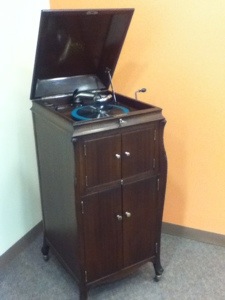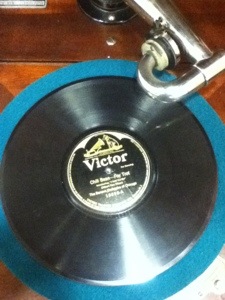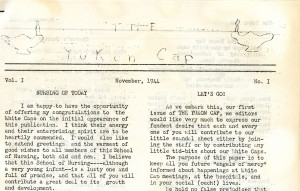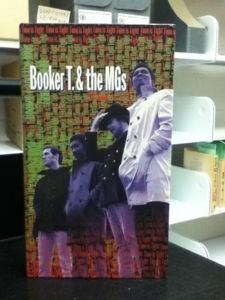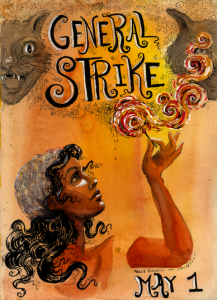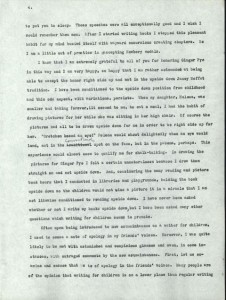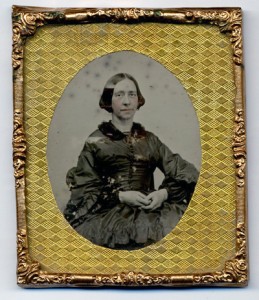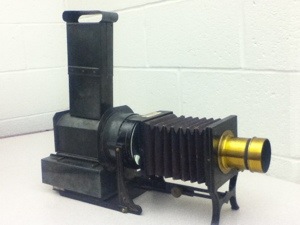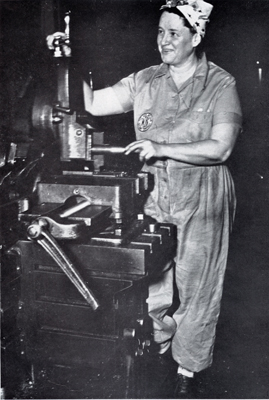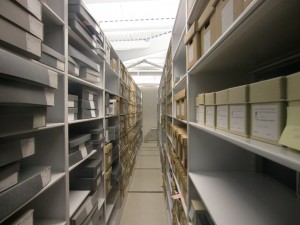Victrola VV XIV, 1917. From the Charters Archives
The UConn White Caps
The School of Nursing at the University of Connecticut was established in 1942 and accredited the following year. The first students received their caps in 1944, an event commemorated in a scrapbook created by the “White Caps,” the nursing student club. The capping ceremony took place on the evening of October 12, 1944 at the Community House situated near the Storrs Congregational Church. Dr. Albert Jorgensen provided the welcome and Dean Carolyn Widmer spoke, reminding “the girls to keep up high ideals in their future years of nursing. Mrs. Widmer then capped each girl, after which Miss Dolan, assistant to Mrs. Widmer, lit each girl’s Florence Nightingale candle. The newly capped girls then took the Cadet Nurses’ Pledge, as all are entering the Cadet Nurse Corps.” [Connecticut Campus, October 1944] The members of the first class in the University of Connecticut School of Nursing included Rhoda Grodin, Marijane Johnson, Selma Mag, Marilyn Olsen, Barbara Payne, Anne Pickett, Elaine Raymond, Shirlee Weinberg and Ann Winchester.
In November 2012, the University opened the Carolyn Widmer Wing of Storrs Hall, the long time home of the School of Nursing. Named in honor of the first Dean of the School, the wing “provides nursing students with a learning environment tailored to the special needs of nursing education and practice” (UConn Today, 11/5/12) underscoring the University’s ongoing commitment to the education and training of nurses symbolized in the capping ceremony so many years ago.
The White Caps’ scrapbook is part of the School of Nursing Records in the University Archives.
Caught My Eye Today
Fifty Years of Anti-Nuclear Power Advocacy: Now Open for Research
During a long career of anti-nuclear power advocacy, from the late 1950s to the early 1990s, Larry Bogart—and his associates after him—gathered together and distributed an enormous collection of information on the hazards of nuclear power. Today the archive serves as a chronicle of the struggle against nuclear power and its grass roots origins. The collection is comprised of 42 boxes, amounting to approximately 54 linear feet, and covers approximately 50 years of time, spanning even after Larry Bogart’s death in 1991. In its extent it is more than a life’s work, and now, after a period of about three months of careful work, I am glad to report is completely inventoried!
The collection is comprised of anti-nuclear power publications from many different nationwide organizations—including his own, such as Nuclear Opponents and Energy News Digest—which show his concern for the nationwide problem, rather than merely local concerns. As can be surmised from the vast quantity of newspaper clippings, though, he devoted much attention to stopping power plants in the Northeast, such as Indian Point in New York, Vermont Yankee, and Seabrook in New Hampshire. His correspondence, though rarer, further indicates a deep devotion to the fight against nuclear power—since it is very nearly the only subject discussed—and correspondence written to him at his various organizations such as the Citizens Energy Council, Friends of the Hudson and the Anti-Pollution League—often requests for information or subscriptions to publications—shows his great importance within this advocacy movement.
The Larry Bogart Papers, rather than a direct biography of Larry Bogart, provides students and researchers with ample source materials for studying the movement as well as the specific concerns of scientists and citizens in the early era of nuclear power. Larry Bogart brought countless clippings and publications into one place from people and organizations from around the world, giving us a collection with a very wide scope. What the collection offers is greater than one person could have produced singlehandedly: a chronicle of fifty years of anti-nuclear advocacy, told in many voices.
Daniel Allie, undergraduate student employee
Caught My Eye Today
#Occuprint
One of our recent acquisitions is a poster collection created by Occuprint of the Occupy Wall Street Screen Printing Guild. The collection consists of thirty-one posters which were selected from hundreds on the Occuprint website. The materials were produced under creative commons allowing for free copying and usage as well as open submission by artists illustrating the occupy movement world wide. These logos and images are now finding their way onto t-shirts, buttons, flyers and websites. The prints began as sketches and signage made on pizza boxes in Zuccotti Park, New York during the Occupy Wall Street encampment which evolved into the polished and colorful images printed by the guild. Demonstration art and signage is not an original artifact of the Occupy movement, as our Poras Collection of Vietnam War Memorabilia demonstrates; infact the modern poster is often reliant on the influences of previous counter culture and purposefully self-aware. However, this material is a representation of demonstration sign art which was never part of the demonstration itself, thereby creating a digital archive of art in a political vein originating across the globe to both mimic the Occupy Wall Street movement and symbolize the individual geographies of protest. Its appeal for mass reproducibility, as occured in previous eras of resistance and demonstration, is in itself a form of protest to the commodification of art as an industry for profit, a root cause of “the 99%” slogan.
These posters can be viewed by appointment only, please contact the curator of the Alternative Press Collection for details. A great resource of digitized demonstration posters from the 1960s and 1970s can be found at the Oakland Museum of California.
Insight on a Fellowship
Glastonbury, Conn., English teacher David Polochanin was recently awarded the James Marshall Fellowship, as he pursues to write young adult literature as part of a yearlong sabbatical. During his research, he will write an occasional series of blog posts, based on his observations and insights relating to the contents of the Northeast Children’s Literature Collection at the University of Connecticut. This is the second in the series.
Blog post 2: On The Psychology Of Writing
“You may think that this is the first Newbery acceptance speech I have ever made. But it isn’t. Long ago, before I ever wrote a book, when I was a children’s librarian and first aware of the Newbery Medal, I used to often put myself to sleep at night making speeches accepting this coveted award. These speeches were all exceptionally good and I wish I could remember them now. After I started writing, I stopped this pleasant habit, for my mind busied itself with wayward excursions creating chapters for… books.”
Excerpt from Eleanor Estes’ 1952 Newbery Medal speech for her book Ginger Pye
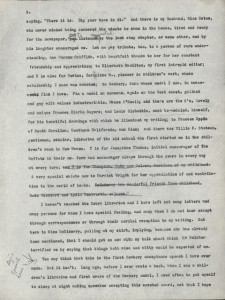
Within the publishing industry, there is a genre subset that exists mainly because of the uncertainty, mystery, and pressure that all writers face – the self-help writing guide. New books are sold every year, offering expert advice on such writerly, often impossible, things as how to summon the muses, where characters come from, the best ways to begin and end a story, if outlining is necessary for everyone, as if these were insider secrets only known to a few. Still, we learn that some authors write early in morning; others late at night. Some claim the best ideas come while taking long walks; others write what they dream and form stories around that.
To prove the marketability of such books, there is still a shelf at your local Barnes and Noble and the UConn Co-op reserved for such titles as John Gardner’s The Art of Fiction, Ray Bradbury’s Zen In The Art Of Writing, Stephen King’s On Writing: A Memoir Of The Craft, Natalie Goldberg’s Writing Down the Bones: Freeing The Writer Within, Anne Lamott’s Bird By Bird: Some Instructions on Writing and Life, and Strunk and White’s The Elements of Style, among others.
As a writer, especially at the beginning, during those fledgling phases when you’ve got 40 pages of something and it isn’t going so well, it’s hard not to look at these books. They are indeed tempting to read. Teachers at the college level routinely assign them as class texts, and the content is often useful, if not entertaining. I’ve bought a bunch of them myself, and every now and then, I return to them for inspiration or direction.
So, what makes me bring up the self-help industry for writers? A progressive-minded document from 1952.
Browsing through the Eleanor Estes papers recently I came upon several drafts of her Newbery Medal speech, given in 1952 for her book Ginger Pye, which stopped me in my tracks. As I read the draft, complete with cross-outs and edits, I stopped at the excerpt at the top of this post and had to reread it. I copied it verbatim on my yellow legal pad. Estes, a former librarian in New York City, said this was not her first speech. She had given many of them, in her head, putting herself to sleep at night imagining that she had won the award. What she was saying could have easily been included in a how-to-write guide; it still could.
With so much written about the psychology of writing – directly or indirectly – the truth remains elusive. What works for some will not work for all. I know for a fact that I do not have the motivation to write at 4:30 a.m., as some writers do. My most productive work time is sometime between 10 a.m. and 2 p.m. It used to be from 9 p.m. to midnight, before my kids entered the picture. I have had numerous ideas come to me while on bike rides and while driving my car, though I would hesitate to say there is a direct correlation between generating writing ideas and movement. Perhaps through doing these activities, my mind has an opportunity to clear out some space for creative thought. But who really knows.
Reading from superior examples in the genre you’re writing seems to help warm up the brain. Perhaps it’s nothing more than mere imitation. But is this scientifically based? I doubt it, or know if it can be. Still, Ted Kooser, the Pulitzer Prize winning poet who has been the U.S. Poet Laureate, in interviews says he has done this, as have many other writers. When I was a journalist at the Providence Journal, before a major assignment an editor once sent me a handful of front-page feature stories from the Wall Street Journal before I started to write one of my own. I did “channel” something from those stories, but I think I was too young to figure out how the articles she sent could help me.
Nevertheless, I guess the Estes comment surprised me because of the time period in which she wrote it, and also because it still makes so much sense today. How could it not help to imagine doing the very thing you want to do? Isn’t visualization/imagery the most primitive version of positive psychology? Estes was priming her brain to write great works, and her nightly fantasizing ritual ultimately gave her a tight focus and, quite likely, a motivation.
It worked for her. Could it work for others?
Sifting through boxes of manuscripts in the Northeast Children’s Literature Collection, I suppose, can have a similar effect: to gain a psychological edge in the writing process. It’s easy to forget sometimes that writing is truly an art form, and that artists need inspiration and particular conditions in order to do it well. Whether it’s writing near the window at Starbucks, which seems to be a favorite for many, or in a secluded study room at a library, I’m not sure if there are any big secrets that will work for everyone. The trick, I think, is discovering what will work for you.
Caught My Eye Today
Caught My Eye Today
Photographs from Archives & Special Collections part of an exhibit at the National World War II Museum in New Orleans
Several months ago I worked with Laura Blum, a student at E.O. Smith High School in Mansfield, Connecticut, who needed photographs from the Connecticut Business History Collections for a project she was working on for the National World War II Museum in New Orleans. Laura was selected, with fifty other high school students in every state in the country and the District of Columbia, to provide images of how their states contributed to the challenges of World War II on the homefront. Laura chose six photographs from our collections, all depicting Connecticut workers and the efforts they made on behalf of the war effort, and wrote an introduction.
The photographs that Laura chose are available in the Connecticut window of the Salute to Freedom website of the National World War II Museum, at http://salutetofreedom.org/. We are happy that Laura used photographs from our collection for this national-oriented project and very impressed with the good work she did in highlighting and describing the photographs.
The museum blogged about the exhibit on December 31, 2012, available here: http://www.nww2m.com/2012/12/student-scholars-honor-local-contributions-to-wwii/
Caught My Eye On Valentine’s Day
Insight on a Fellowship
Glastonbury, Conn., English teacher David Polochanin was recently awarded the James Marshall Fellowship, as he pursues to write young adult literature as part of a yearlong sabbatical. During his research, he will write an occasional series of blog posts, based on his observations and insights relating to the contents of the Northeast Children’s Literature Collection at the University of Connecticut. Polochanin’s work has been widely published in major newspapers in New England, including The Boston Globe, Providence Journal, and Hartford Courant. His education writing has appeared in Education Week and Middle Ground, and his poetry has been included in an anthology by Native West Press, and will be published in the prose poetry journal Sentence.
Blog Post 1: On Production
Combing through the archives of this collection has been fascinating, and an extraordinary opportunity. Since my days as a reporting intern for the Boston Globe nearly 20 years ago, I’ve been interested in authors’ behind-the-scenes writing process – perhaps because the art of creation is typically so mysterious. After all, when authors are interviewed by admirers, one of the first questions they are asked is, “How did you write this?” or “Where did the idea come from?”
I am not so much interested in where ideas come from, but I am intrigued with the process of writing itself.
In a way, I am learning that it is not so complicated.
While I have examined only a fraction of what the Northeast Children’s Literature Collection holds, I am struck by the sheer production of some of these authors, the volume of work they have created, and that, it would seem, an author’s ability and determination to produce such large amounts of work are major factors leading to publication, success, accolades, fame. This drive ultimately distinguishes a recreational writer, I think, from writers who earn a living by writing, particularly as a creative writer, for adults and children alike.
Their success is not reliant upon talent, alone.
It takes tenacity to produce. I am reminded of an interview I read recently with Newbery Medal winning author Kate DiCamillo, posted on the website ReadingRockets.org. She said, “I’ve been in so many writing workshops, writing classes, and to the right of me and to the left of me, there’s always somebody much more talented than I am. And what I figured out is they’re not willing to go through the rejection, which is enormous, and then the compromise that comes with editing your work. I decided a long time ago that I didn’t have to be talented. I just had to be persistent, and that that was something that I could control — the persistence. I’ve always been kind of persistent.”
Again and again in author interviews, this is a common refrain. In order to publish your work, one must work hard. Sounds simple. But the determination involved when there are dozens of things vying for our time, is remarkable. It means casting these distractions – the Internet, TV, the laundry, the long shower – aside to sit somewhere and write for extended periods of time. In today’s society, a place where patience is underrated, this kind of discipline is increasingly difficult.
So when I look through boxes of drafts, notes, and manuscripts by such celebrated children’s authors as Eleanor Estes and Ruth Krauss, whose works are well represented in the Northeast Children’s Literature Collection, seeing the sheer amount of their work stacked in box after box on the shelves in the back room, you begin to get a sense of why these are noteworthy writers and why their work is housed in a university archive.
Writing is a way of life. And you can tell that many of the writers here have dedicated their lives to the craft, to creating stories, poetry, or nonfiction. They have been prolific producers. It’s not unlike any other line of work that requires intense focus and discipline in order to rise to the top of a profession. The best physicians are often board-certified, keep up with current research, and teach young doctors in training; the best NBA players spend hours beyond their usual practice and game time to practice three-pointers and free throws and watch video of their games.
‘Consuming’ is the right word to describe this sort of dedication.
In his book The Outliers, author Malcolm Gladwell theorizes that it takes 10,000 hours to become an expert at a craft, including reaching the highest levels of achievement in business, technology, sports, and music. I’d argue the same goes for writing. Over 10 years, that’s 1,000 hours a year, or 83 hours a month, 19 hours a week, or about three hours a day. Of course, this is provided that you write every day.
Poring through this collection’s files and folders and the sheer volume of production included here makes it clear, at least in my mind: the more a writer produces, the more likely they are to get published, and the more likely one is to eventually publish work of enduring value. Kate DiCamillo has it right: First comes a stubborn persistence, then comes talent.


